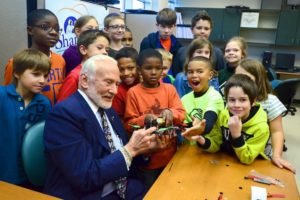
A provision in the current version of the National Defense Authorization Act (NDAA) would make it significantly easier to use drones for education.
As the final version of the NDAA approaches a vote, issues including a proposed ban of Chinese-made tech have been negotiated. The Academy of Model Aeronautics (AMA), the largest community-based organization (CBO) for recreational drone and model aircraft flyers, points out another important provision for the drone industry: Sec. 1087 would further enable drones for educational purposes.
The relevant text of H.R. 6395 amends a section of the FAA Reauthorization Act of 2018 which limited the educational uses of drones, adding sections that would allow drones to be flown at elementary or secondary schools, as part of Junior Reserve Officer Training Corps (JROTC) programs, or as part of an educational program chartered by a CBO.
The advantage of enabling drone use in a JROTC program is clear: drones already have a significant place in military operations of all types, in both battle training and peacetime operations. Drones for education have also proven a valuable addition to STEM and other programs, providing exposure to a wide field of science and technology related topics for students of all ages. Allowing these educational programs to operate under the charter of a CBO gives schools and communities an easier path for meeting regulatory requirements.
Building a Culture of Safety
The provision opens the doors for the AMA and other CBOs to offer training and educational classes that promote safe drone operation. As the FAA and the commercial drone industry call for the development of a safety culture around drone use, this provision provides a practical path for inducting young aviators into that culture, while training the next generation of the drone industry workforce.
“If signed into law, the UAS amendment to the NDAA bill will allow JROTC programs to operate for educational purposes and other primary and secondary educational programs to operate under a recognized community-based organization like the Academy of Model Aeronautics,” says Tyler Ddobbs, AMA Director of Government Affairs. “This significantly reduces the regulatory burden on JROTC and educational groups, gives them access to a community of experienced aviators and, ultimately, will allow more people to safely learn. The amendment is great news for educators and young people who will go on to serve in high-demand STEM-related fields, as model aviation has proven to be an effective tool for instructing and training new generations of aviators, engineers, and more.”
Miriam McNabb is the Editor-in-Chief of DRONELIFE and CEO of JobForDrones, a professional drone services marketplace, and a fascinated observer of the emerging drone industry and the regulatory environment for drones. Miriam has penned over 3,000 articles focused on the commercial drone space and is an international speaker and recognized figure in the industry. Miriam has a degree from the University of Chicago and over 20 years of experience in high tech sales and marketing for new technologies.
For drone industry consulting or writing, Email Miriam.
TWITTER:@spaldingbarker
Subscribe to DroneLife here.